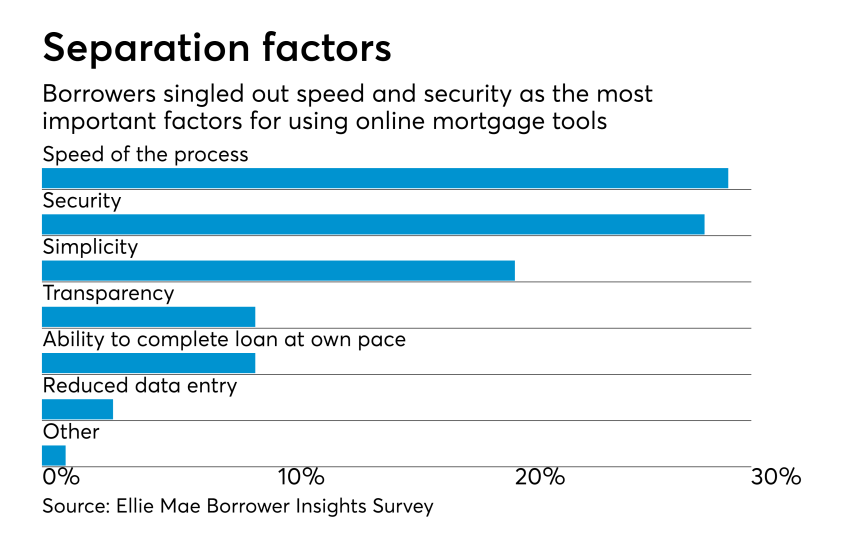The origination segment has garnered much of the digital mortgage attention in the industry, particularly when it comes to customer experience and satisfaction. But incorporating many of those same processes into the servicing side of the business presents an attractive opportunity to realize those same objectives, particularly for borrowers facing financial difficulties.
The industry is accelerating the pace of technology adoption to develop a more efficient process, but efforts to streamline the mortgage market haven't strayed much from the
originations sector. While lenders are deploying consumer-facing digital tools that offer streamlined processes to apply and get approved for a loan, default servicers are often relying on disjointed systems and fax machines to process loan modifications and other forms of loss mitigation.
At a time when the industry is obsessed with customer experience, it seems ironic that default — perhaps the most stressful and complex aspect a borrower encounters with a loan — has largely been an afterthought in the digital mortgage revolution.
After all, the steps involved in executing a loan modification share a
striking resemblance to underwriting a new mortgage.
"Default is really the last island yet to be overtaken by the tide of new technology, and that's because it's more complex; there's a lot of dimensionality in default, a lot of different data, a lot of different participants," said Steve Horne, the former CEO of Wingspan Portfolio Advisors, a specialty servicer he founded in 2008 and operated until it declared bankruptcy in 2016.
"That being said, technology is catching up," Horne, now the CEO of consulting firm Alta Vista Advisors, said.
In the run-up to the housing bubble burst, the mortgage industry had little incentive to offer, let only streamline, loss mitigation processes. Home prices were soaring, delinquencies were low and the small volume of defaults that did exist were tolerable risks.
But after the Great Recession, an influx of loss mitigation programs and new regulations were created to address the mounting foreclosure problem. Servicers were too overwhelmed to innovate.
But today's mortgage environment, filled with a thirst for technology and
far fewer delinquencies, weaves together the perfect circumstances for an overhaul of default servicing.
"The crisis took everybody there in order to manage through it, and now that the crisis is over and the default numbers are at record lows, it's time to play catch-up in that space and look at how can we provide the best consumer experience for our clients and customers that are going through a tough time," said Anne Beck, product manager at Fiserv Lending Solutions.
Vendors like Fiserv have developed loss mitigation tools, including online borrower portals, to make it easier for borrowers to apply for loan modifications. Meanwhile, Quicken Loans is applying its Rocket Mortgage approach to loss mitigation.
"It's not the sexy part of servicing; it's not the flash and bang or the thing that you go out and promote," said Nicole Beattie, vice president of servicing at Quicken Loans. "It's an underserved area of the market that we just thought differently about and said, regardless of what a client may be going through, regardless of if they're performing or not performing, they deserve the exact same respect and we should invest in our technology regardless of the client's situation."
Quicken's loss mitigation platform, called Rocket Solutions, provides responses to consumer mortgage modification requests via Rocket Mortgage's servicing website.
Servicers have now had a number of years to implement and understand the myriad new regulations on their segment of the industry. That's now making it easier to develop technology to streamline and automate compliant processes.
"I think new technology is 100% aligned with the new compliance and regulatory requirements because it's all about transparency at the end of the day, whereas older systems were about really anything but," said Horne.
Instead of being manual laborers by collecting and passing on data, default servicers can focus on overseeing processes to ensure borrowers are delivered the best possible outcomes for their situations.
"It will rework everything in the industry, and if you look at the new wave of technology coming into the financial services space, it has completely redone unsecured lending, consumer lending and even made strides on mortgage origination, which is changing all of the roles," Horne said.
This shift also helps servicers make better use of their employees.
"We don't need as many team members making the decision. We've now put them as part of the defense and said, 'Now you're going to audit to make sure that the product that we're delivering is 100% the right decision for the client,'" said Beattie.
While the originations segment is leading by example in its pursuit of a completely digital mortgage, it's unrealistic to think that the default servicing sector will ever be fully automated, which is probably for the best, according to Beck.
"You cannot really manage through a modification process, or a short sale, or a deed in lieu, without having physically spoken to your servicer," she said. "But it's taking those first steps and taking the process of getting the documentation and understanding the process better that's helpful. So much of servicing still relies upon getting a faxed document."
— Elina Tarkazikis 








